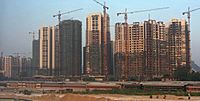
Photo from wikipedia
Abstract The rapid urbanization process has posed great challenges to China's energy system. This paper uses the Stochastic Impacts by Regression on Population, Affluence and Technology (STIRPAT) model to evaluate… Click to show full abstract
Abstract The rapid urbanization process has posed great challenges to China's energy system. This paper uses the Stochastic Impacts by Regression on Population, Affluence and Technology (STIRPAT) model to evaluate the energy-saving effect of China's urbanization based on provincial panel data. The results suggest that: 1) The urbanization induces the energy consumption with a notable negative energy-saving effect; 2) The heterogeneity of urbanization impact on energy consumption is analyzed in different stages of urbanization, showing that the energy-saving effect of urbanization follows a U-shaped path; 3) Considering the heterogeneity of the energy-saving effect of urbanization at different income levels, the energy-saving effect increases with income level. The outcome may draw a causation picture on the relationship between energy consumption and urbanization. In addition, an in-depth causation analysis on energy inefficiency of China's urbanization is carried out and policy recommendations are put forward accordingly.
Journal Title: Journal of Cleaner Production
Year Published: 2017
Link to full text (if available)
Share on Social Media: Sign Up to like & get
recommendations!